Writing the Script
The brief for Professor Ray Laurence was to write a script of 140 words and to put into that 140 words as much content as possible. Sounds impossible, after all, most academic articles are around 8,000 words or more.
Here is the script for the film - 127 words in total:
Archaeologists have uncovered household shrines in many houses in Pompeii. These help us to understand how the Romans imagined their gods. This shrine includes painted images of the Lares – gods to protect the family and a snake to represent the genius of the paterfamilias, who guided his actions. Statuettes of gods were placed in Lararia in Pompeii. We find a fistful of gods in most houses, say, Jupiter with Juno, Venus, Hercules and Persephone – some Pompeians included Egyptian deities, such as: Anubis and Horus. This house shrine is also decorated with a fresco of mount Vesuvius with the god of wine, Bacchus with his panther, covered in grapes with birds passing overhead. It all looks so idyllic, but we of course know what happened in 79 AD.
Elements in the film
1) The Fresco of Vesuvius
This fresco has been reproduced in books on Pompeii time and time again, but there is little recognition of where the fresco originally came from. It was removed in the 1870s from the wall of a Lararium in what became known as the House of the Centenary and placed in a frame to be displayed as it is today in The National Archaeological Museum in Naples. If you visit this house today, you will see that the right wall of the Lararium has a section of fresco that is missing. For this film, Ray wanted to put the fresco back into its original context and to show viewers where it belonged in ancient Pompeii - alongside the worship of the gods in a private house. This fresco is pretty unique - it is the only visual representation of Vesuvius in antiquity. There are no graffiti of Vesuvius and mostly there is an absence of information about the dormant volcano, but see discussion of Martial’s poem in the next section. The uniqueness is, in itself a reason for comment, why is the fresco located in a lararium of household shrine to the gods? We can see the god Bacchus in the fresco - covered in grapes and we know that vineyards were scattered on the lower south to south-easterly slopes of the mountain, in other words the side of Vesuvius closest to Pompeii. However, if we understand a Lararium as a place in which the gods ensured the well-being and good fortune of the family. Then, we might see that well-being linked to the good fortune obtained from vineyards and the benefits bequeathed to the Pompeians by the god Bacchus, the god of wine. Alternatively, the presence of an image of Vesuvius in a lararium may refer to knowledge of how a volcano might affect the well-being not just of this family, but of the town itself. You can see more images of the lararium of this house and the position of the Fresco of Vesuvius by following this link to Pompeii in Pictures.

Fresco of Vesuvius from the Lararium of the House of the Bicenteary
Carole Raddato from FRANKFURT, Germany</a>, CC BY-SA 2.0, via Wikimedia Commons
2) Did the Pompeians fear an eruption?
The ancient geographer, Strabo made the connecion between Vesuvius and Etna as volcanoes in c. 15 CE. Vesuvius was dormant; whereas Etna was an active volcano. Yet, he makes observations of those two volcanic landscapes that show a consciousness that Vesuvius had the pottential to erupt again like Etna. Interestingly, Strabo also connects the volcanoes to the soils that were appropriate for viticulture and the production of wine. Here is what Strabo says:-
‘Above these places lies Mt. Vesuvius, which, save for its summit, has dwellings all round, on farm-lands that are absolutely beautiful. As for the summit, a considerable part of it is flat, but all of it is unfruitful, and looks ash-coloured, and it shows pore-like cavities in masses of rock that are soot-coloured on the surface, these masses of rock looking as though they had been eaten out by fire; and hence one might infer that in earlier times this district was on fire and had craters of fire, and then, because the fuel gave out, was quenched. Perhaps, too, this is the cause of the fruitfulness of the country all round the mountain; just as at Catana, it is said, that part of the country which had been covered with ash-dust from the hot ashes carried up into the air by the fire of Etna made the land suited to the vine; for it contains the substance that fattens both the soil which is burnt out and that which produces the fruits; so then, when it acquired plenty of fat, it was suited to burning out, as is the case with all sulphur-like substances, and then when it had been evaporated352 and quenched and reduced to ash-dust, it passed into a state of fruitfulness.’ Read more from Strabo on Pompeii here.
Diodorus Siculus (60-30 BCE) sets out the movements of Hercules that includes an account of Vesuvius, that he sees as an ancient volcano similar to Etna. Link to the text is here, you need to read section 21. After the eruption, Statius (Silvae 4.4.78-85) saw Vesuvius as a revived volcano to rival Etna, and Martial (Epigram 4.44) connects Vesuvius prior to the eruption with Bacchus, but afterwards comments that not even the gods would wish to have the power of a volcano. Link to the text is here, you need to read section 4.44.

Mount Etna in Sicily. Image by Wrobell, CC BY-SA 4.0 https://creativecommons.org/licenses/by-sa/4.0, via Wikimedia Commons
3) Children and Religion
A question for all things to do with Pompeii, should be the participation of children. If our demographic estimates are correct, at least fifty percent of the population of Pompeii would have been under the age of 20 years. Thus, it is essential to understand how children might have interacted with the material remains of Pompeii. I think we can say this is as important as accounting for the actions of the adult half of the population. One way of seeing whether children can interact with a lararium is to estimate the growth of a Pompeii boy into an adult of c. 164 cm tall or a girl to become an adult with an average height of 154 cm. Paediatricians have provided the modern world with data for the growth of children and we locate a growth curve to the heights of Pomepian adults. Armed with this data, we can then assess whether the niche in the larararium of the House of the Centenary was accessible to chidlren. The low walls to a height of 80 cm, if a gate was present could have excluded younger children below the age of 7 years, but most children able to stand and walk would have been able to see the statuettes present in the lararium. This article has a full discussion of the accessibility of lararia, waterfountains, bar counters for children in Pompeii.
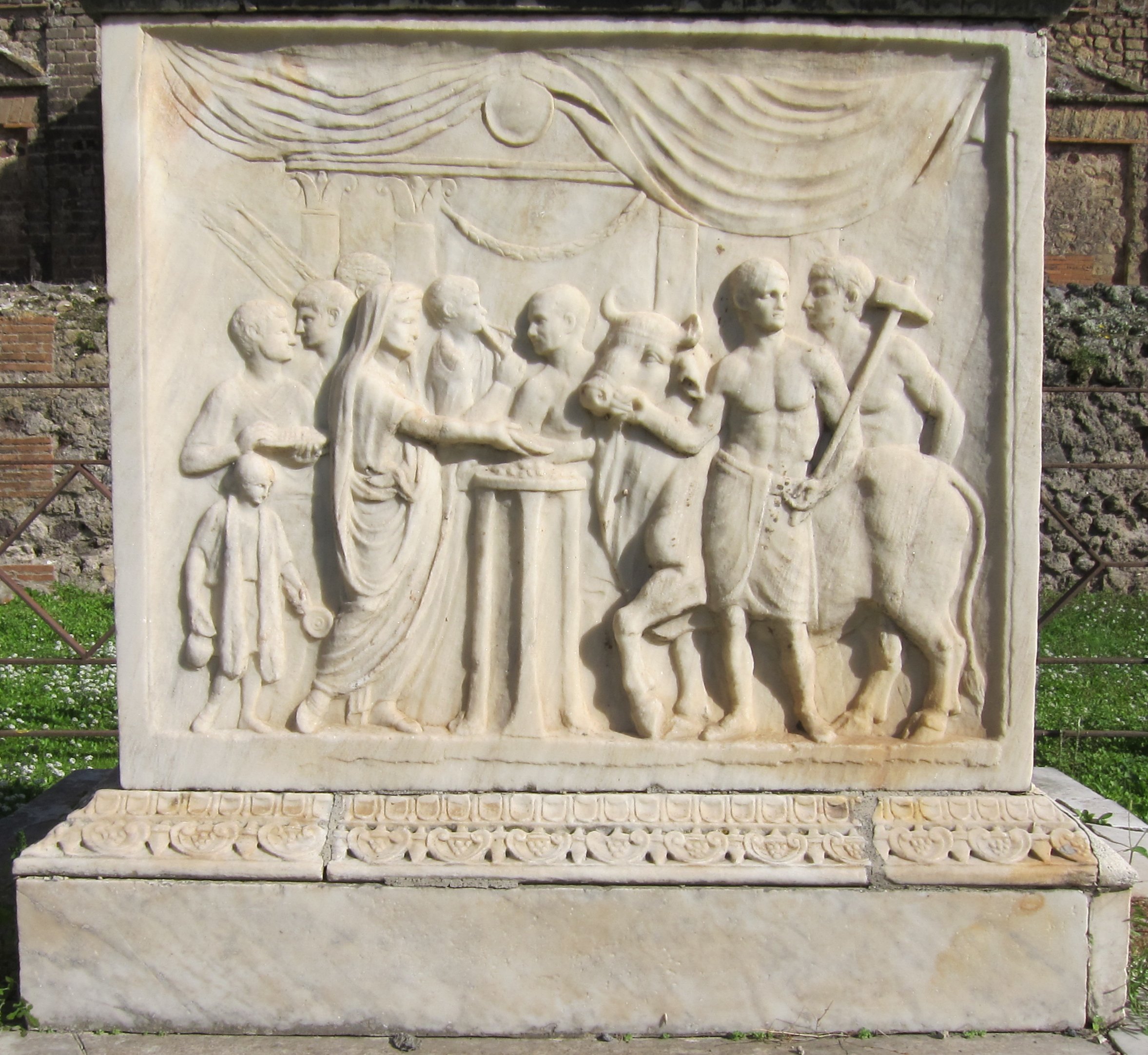
Note the positioning of a child in this sacrifice scene from the Temple of the Genius of Augustus in Pompeii Image by Wmpearl, Public domain, via Wikimedia Commons
4) The Lararium in the House of the Centenary
Luigi Bazzani painted a watercolour of the lararium in 1882, three years after the excavation of the House of the Centenary. The colours are particularly vibrant and show the subtle use of colour - black where dirt might form and lighter colours as we move up the wall in height. The niche of this household shrine is flanked by two lares painted into the frescoed wall. These dancing gods protected the household, we also find them at crossroads, see Episode 1. The niche is a key feature of lararia and this one is further defined by blue paint. No statuettes were recorded in the niche itself. We have to wonder whether those leaving the house may have taken these images of their gods with them. Just as Aeneas took the Penates, gods of the storecupboard from Troy as the city was being pillaged by the Greeks.

Water colour of the Lararium of the House of the Centenary, June 1882 Image by Luigi Bazzani, Public domain, via Wikimedia Commons
5) Was there a standard shape for lararia in Pompeii?
Lararia appear in all shapes and formats. They can be positioned in the atrium of a house or out of the public gaze close to where food was being coooked in kitchens. However, they share a common feature - in all cases they are designed to be seen and to contain statuettes of gods. Which gods were chosen to be included seems to have been very flexible and subjec to personal choice by those living in the household. This can result in the combination of gods that can include both the Greco-Roman gods, such as Venus, Juno, and Jupiter, and also Egyptian deities, such as Horus and Anubis. This is something of a challenge for us to comprehend, because education systems and even the very structure of the discipline of Archaeology likes to separate ancient cultures and keep them apart: ancient Egypt, ancient Greece and ancient Rome. Yet, in antiquity, we can find clear evidence of a mixing up of these cultures with gods included in lararia that sit in the traditional Roman pantheon alongside Egyptian deities. These combinations of gods in lararia await a full study, but some of the evidence from excavations has been lost. Even so, a study of these combinations of gods would open up how the Pompeians saw the gods in these lararia - there’s a PhD thesis topic for someone!
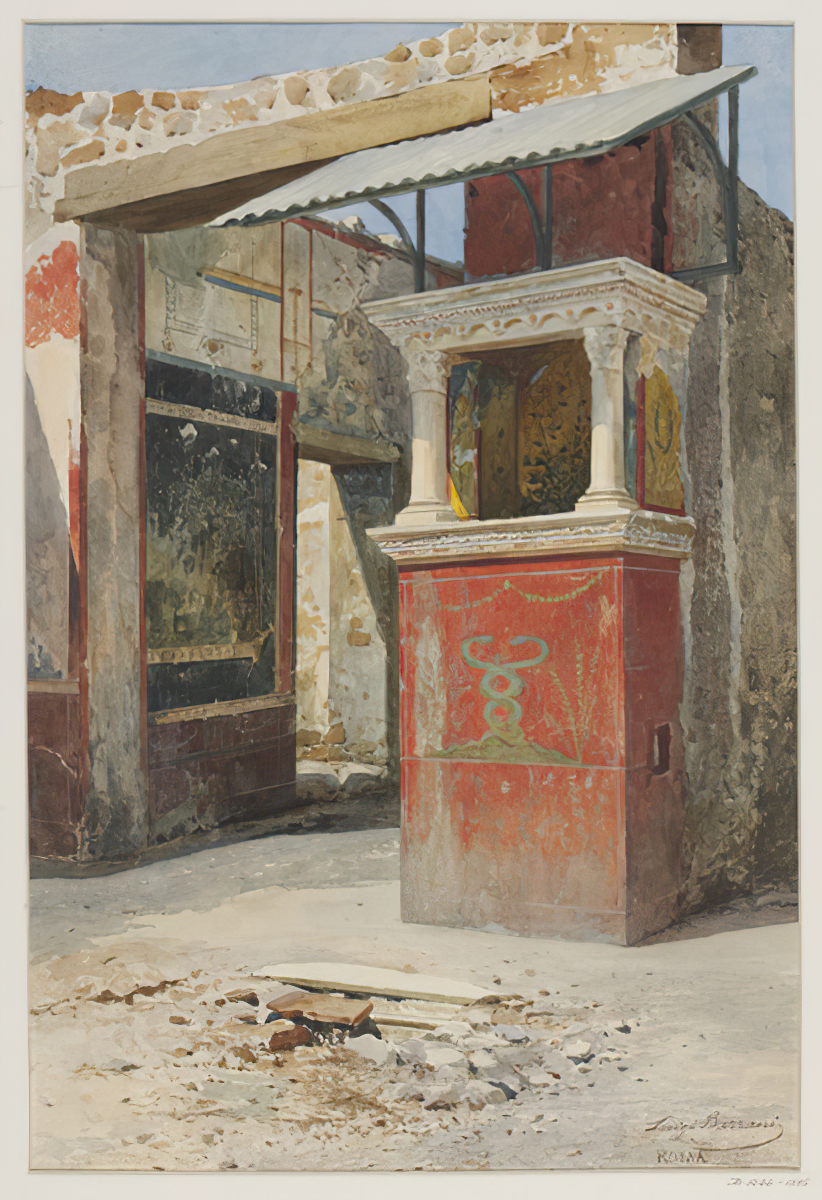
You can compare this lararium with that of the House of the Centenary to identify the few features that they have in common and how they differ.
Image by Luigi Bazzani, Public domain, via Wikimedia Commons.
6) Statuettes in a Lararium from a Rural Villa
A rural villa excavated in the 1899 outside Pompeii was found with a number of bronze statuettes of gods and goddesses. None of them were made to the same scale and this did not seem to matter to those who worshiped at this lararium. The variation in size may point to each statuette being an addition made at a different point in time. This might mean that the objects in a lararium became a form of household archive, which via the addition of the various statuettes created the means to remember family history. There was always the possibility of adding addiional gods and goddesses in the future. In this example, we can find: Venus (2), Isis (5), Harpocrates – the god of silence/secrecy (3 & 4) and Serapis (7), alongside a snake ring. Also found in the same room was a bust of a male and a statuette of a bull. There was also a large stand on which a lamp could be placed. You can read more about these finds here.

Statuettes from a Lararium
Image by Jamie Heath, CC BY-SA 2.0 https://creativecommons.org/licenses/by-sa/2.0, via Wikimedia Commons
7) The Position of the Lararium in the House of the Centenary
Take a look at the plan of the House of the Centenary with the position of the Lararium marked. You can see that it lies at the end of the corridor leading from the atrium and is also aligned to the side door of the house. This places the lararium at the intersection of two routes through the house. It is closest to the service quarters of the house, where food was prepared - whereas the more luxurious elements of the house were at a distance - a fountain or nymphaeum and fishpond or the mosaic of Medusa with images of city walls and ships You can investigate the house through the plan of the house in this link, Note number 23 on this plan is the Lararium

House of the Centenary with Position of the Lararium marked. Image by Johannes Overbeck and August Mau, Public domain, via Wikimedia Commons
8) The State of Conservation of the Lararium
Looking at the watercolour of the lararium from three years after its excavation, we can appreciate the vibrancy of the colours. Familiar to us today from news items reporting newly excavated buildings in the 21st century in Pompeii. However, there is a problem with excavating any structure with a flourish and a news story - attention wanes and moves onto the next sensational find. More than 100 years after its excavation the House of the Centenary has lost its shine. The sensational must see newly excavated house from 1879 has been eclipsed by more recent excavations, such as the House of the Vettii, excavated in 1894, or the House of the Menander, excavated 1928-1932. Let alone the more recent excavations of Region V in the last decade. Once upon a time, in 1879, this house was the Pompeii sensation reported by newspapers across the world! Take a look at recent photographs of the state of conservation of this important lararium in the House of the Centernary.
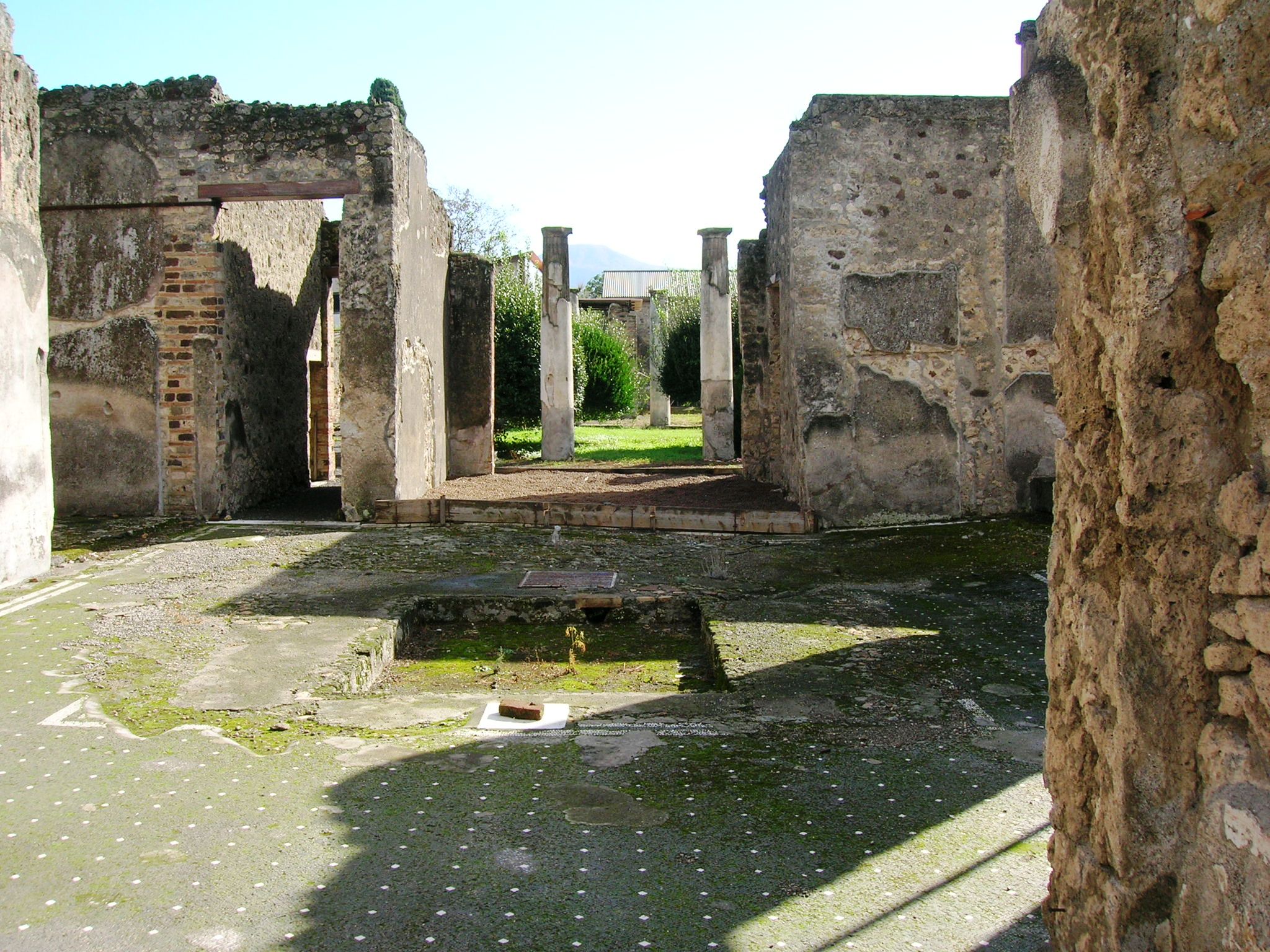
The Atrium of the House of the Centenary in 2011. Image by Mentnafunangann, CC BY-SA 3.0 https://creativecommons.org/licenses/by-sa/3.0, via Wikimedia Commons
9) 1879 Celebrating a Centenary - Press Stories across the World
The correspondent for The Times on 25 September 1879 reported on the three hours that he witnessed the excavation of a shop (presumably adjacent to the main entrances of the House of the Centenary) “the people were gathered around, on the level of the street, on the banks of scoria above, on every spot along the tops of the ruined walls…the persons of higher social and political rank had to take their chance in the crowd with the rest. It was a population of the 19th century pressing eagerly forward with wonderous eyes to see material pages of the history of apeople of the first century unfolded before them.” It seems that lapilli were removed to a level and then the finds emerged: bronze and terracotta vessels and small pottery items described as bird feeders, alongside carbonised millet seed and other grains. Then skeletons of song birds emerged, alongside rings and pieces of bronze that were interpretted as cages. The crowds departed in carriages and by trains put on for the occasion. He made a fuller report on the 29th of September on the celebration four days earlier, at 7 am, crowds headed for the station in Naples to get the train to Pompeii - 6,000 to 7,000 tickets had been issued for the day. First stop was the Basilica and an address by the Director, Michele Ruggiero, which was followed by visits to ten locations in Region IX, where the crowds witnessed excavations from noon to 3pm. This celebration of the centenary, involved the sense of witnessing discovery - familiar to many today from the UK’s Time Team series or in documentaries from Pompeii tha show recent discoveries. Until I looked into the newspaper accounts of the event, I’d never heard of the shop that seemed to sell feed for birds and caged birds. I know of nowhere that this shop can be read about and, given ten excavations were conducted on 25 September 1879, we can only know its location as in Region IX. A record at least, but one that is wholly unsatisfactory.
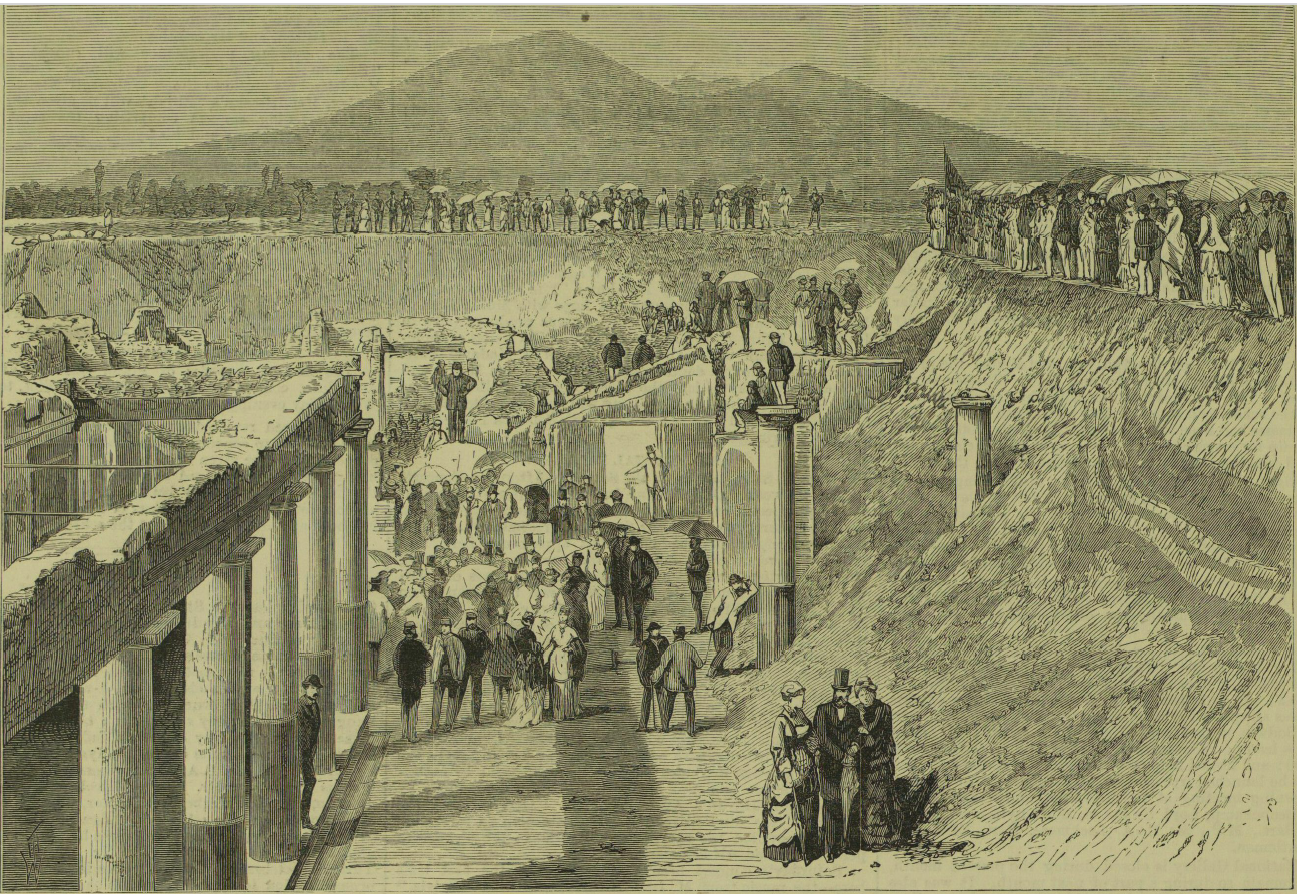
Image from Newspapers around the World: Visitors to the House of the Centenary in 1879
10) Graffiti in the House of the Centenary
Graffiti have been found in the House of the Centenary, we moved one of these with beautiful lettering onto the Lararium in the film, because we wanted to include it. We’ve added another in the same lettering with very similar subject matter, but a personal attack on an individual called Martha. Graffiti often attacks others by name in Pompeii. Both are illustrated here as published in the 19th century as transcriptions. In the captions, we’ve provided translations by one of Associate Professor Ian Plant’s Latin classes at Macquarie University, as he said “quite a contrast to Pliny we had just read!”. This reveals an important fact about graffiti, this is the people’s language - whereas Pliny wrote his letters for publication and to reflect well upon himself.

Translation: One day for sure you’ll attest to what I think: when I need to crap I’ll come to crap.

Translation: This is Martha’s dining room, because she shits in the dining room.
11) A Runaway Slave
We often refer to writing on the walls in houses as graffiti, but this piece of text records an event in the lives of the people who lived in the House of the Centenary. A slave Officiosus fled four days before the Ides of November and then the year is recorded with reference to the consuls in Rome. This translates to 15 CE. It was written on a tile and kept in the house, presumably nailed to the wall. Interestingly, the writing survived for a further 64 years through to the eruption of Vesuvius. Other examples have been found: “Polycarpus fugit” and a multiple flight of household slaves “Vicinos fugitivos”. Such runaways were hunted down. You can read more about this aspect of society in a blog post by Keith Bradley

Translation: Officiosus fled four days before the Ides of November, consuls Drusus Caesar and Marcus Junius Silanus = 15 CE.
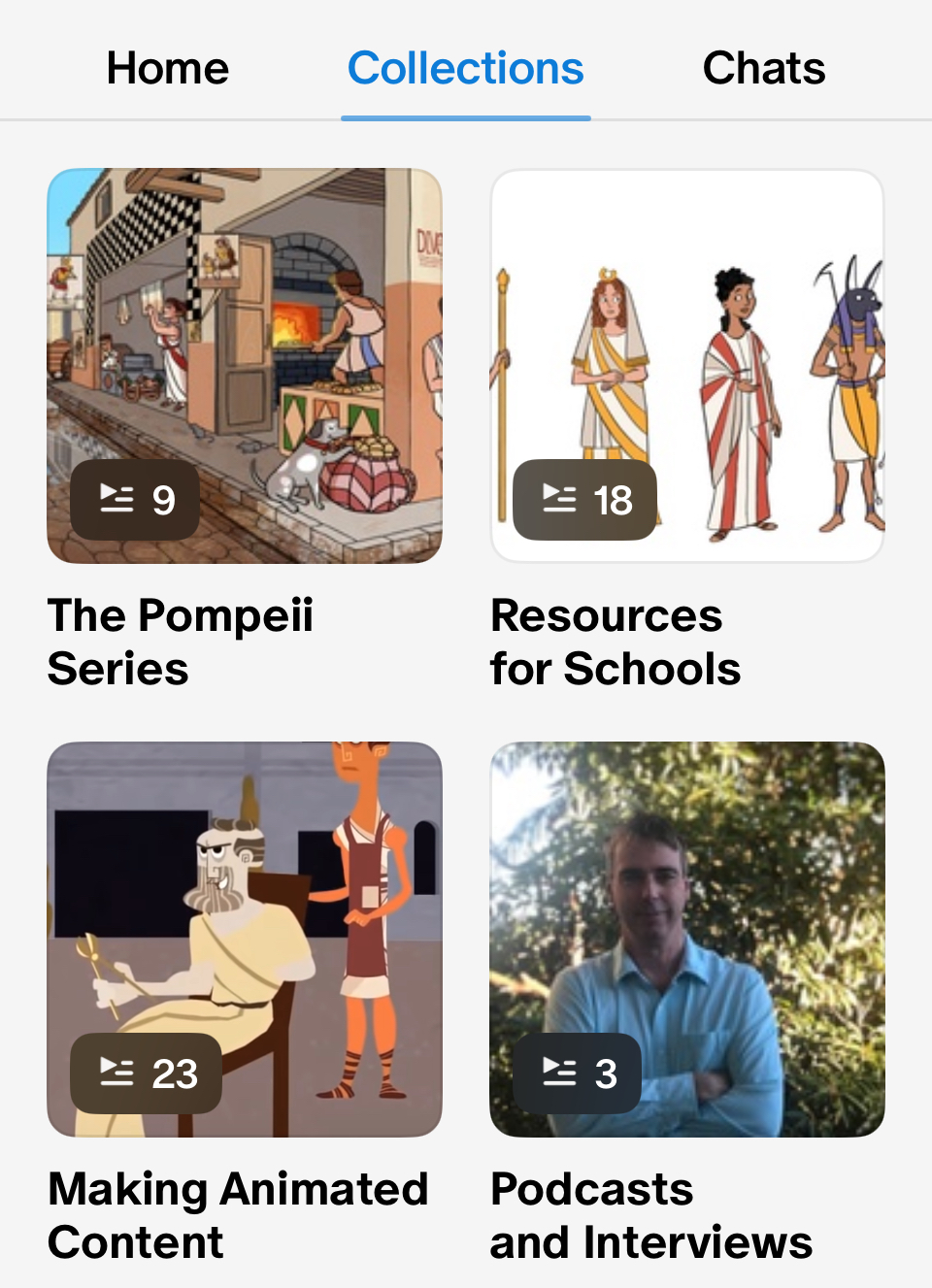
Donate
Our supporters on patreon allow us to develop more resources for teachers, explainers, and videos!
Donate on Patreon